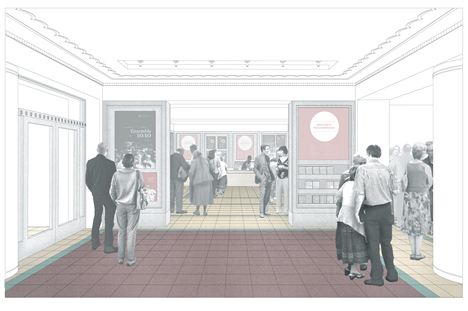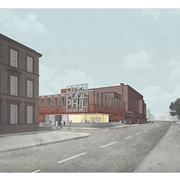LIVERPOOL'S Philharmonic Hall faces a six month closure in 2014 to enable a £12m facelift to be carried out.
It follows the approval by Arts Council England of a £7.5m grant towards the cost of the work. The city council has already agreed to give £2m towards the scheme – providing the Arts Council came up with its slice of cash.
With another £1m raised or promised by private gifts and donations, it leaves the Phil with a shortfall of around £1.5m. So in September Liverpool Philharmonic will be launching a public giving campaign.
The Grade II* listed building, designed by celebrated Liverpool architect Herbert Rowse, celebrates its 75thanniversary in 2014.
 Entrance Foyer And Box Office Perspective
Entrance Foyer And Box Office Perspective
The hall will face a shutdown from May next year until the end of October to enable the work to be carried out.
But the Phil will not be repeating it’s Summer Pops adventure of the 1990s when it took up residence on the Liverpool Waterfront in a big top.
Instead the orchestra will be performing in venues such as the Concert Room at St George’s Hall, the Epstein Theatre, Hope University’s Cornerstone Theatre, in Everton, and other venues.
Usually the hall is closed during August for its annual maintenance, but it is actively used for the rest of the year.
Having successfully applied for seed funding of £634,000 from the Arts Council last year, Liverpool Philharmonic appointed architects Caruso St. John to lead a team in developing the designs for the refurbishment of the 1939 concert hall.
Designs for the refurbishment to Liverpool Philharmonic Hall include:
-
significant improvements to front of house areas and facilities for all visitors and participants including the foyer, box office, bars and catering, toilets and lift access to all levels of the building
-
rebuilding and improving the stage and choir performance areas in the auditorium
-
new warm-up, practice and backstage facilities for resident and visiting musicians and artists
-
a new performance space for a range of small-scale concerts, learning events and other activities
-
increased environmental sustainability, including the ability to reduce power consumption across the building’s utilities.
New lifts to all floors will enable the Phil to provide extra spaces for disabled concert-goers.
 The back endThe full programme of works will be completed during 2015, the 175th anniversary of the founding of the Royal Liverpool Philharmonic. Liverpool Philharmonic is currently planning artistic activity during the closure period and details will be announced shortly.
The back endThe full programme of works will be completed during 2015, the 175th anniversary of the founding of the Royal Liverpool Philharmonic. Liverpool Philharmonic is currently planning artistic activity during the closure period and details will be announced shortly.
Mayor Joe Anderson said: “Liverpool Philharmonic Hall is a world-famous cultural institution and I am delighted that Arts Council England has backed it with this funding.“The refurbishment will give a new lease of life to this much-loved building, enabling it to be enjoyed by generations to come. I am delighted the city council has been able to support this important project.”
Notes and quavers….
There has been a Liverpool Philharmonic Hall on the same site on Hope Street since 1849.
The original Hall, designed by architect John Cunningham opened on 27th August 1849 and was destroyed by fire on 5th July 1933.
A new Hall opened on 20th June 1939 designed by architect Herbert J. Rowse whose other buildings in Liverpool include Martin’s Bank, India Buildings and the Queensway Tunnel entrances, toll booths and ventilation building exteriors.













